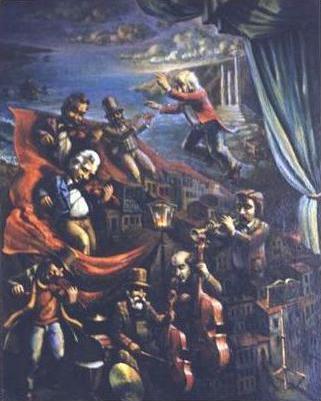Around the World

Symfonie ( 90x70) 1986
Around the World…
It would be incorrect to assume that one short critical note would allow a profound insight into the world of a sophisticated artist, including the world of a painter such that Rafael Ruben (54) is, born in Tbilisi, Georgia (former Soviet Union), now settled in Leiden, the Netherlands, having produced more than 300 perfect tableaux for about a quarter of a century.
One need not make an extraordinary effort to be drawn to his picturesque paintings. Inside any exhibition or art collection that boasts his works, you will be attracted to the harmony of the warm golden gamma, similar to that of the Old Dutch paintings of his mid 80’s works, and to the pure blue-red-yellow colours of his matured, modern works which seem to come from the ancient Orient (Armenia).
This bright palette is complimented by skilful and absolutely professional technique. One can see definite relief contours stress the silhouettes of the symbolic images and personages realistic enough but far from being rote copies of nature.
Generally speaking, Rafael Ruben’s paintings may be interpreted as modernism, even avant-garde and cubism. Russia was famous for this trend in the 1920’s, and this style was modified and revived in the 1980’s as a freedom movement and a protest against the “official art” of the state.
Rafael Ruben belongs to the “gone by the wind” generation. His earliest works appeared in the beginning of the 1980’s.
Settled in the Netherlands by the beginning of 1990’s, Rafael Ruben devoted his life totally to Art. His new way of living, the isolation from the artists’ community of his native country and the European bohemian surroundings helped him to concentrate on the World of his own images.
He never uses any models or open-air sketches to create the mystical aura of his pictures. His experiments with new techniques, such as using customized palette knife and squeezing his palatte of colors to the maximum, invite us into the glimmering, unreal, mysterious space created by the artist.
As far as the subjects of his tableaux are concerned, they reflected the dreams of the fresh air of changes, travels to other countries, freedom of creativity and individual independence suppressed by the forces of the period.
Let us glance at the colourful series of pictures of Rafael Ruben. It will not be complicated to understand the message of the artist, hidden but clear to his audience. It may not be a wide audience but still, in every country, you will find intellectuals and open-minded people in all walks and stages of life enjoying the kaleidoscopes of colourful and funny personages of his early works, and also the calm and philosophical images of his matured pictures .
There are his favourite Circus images in several of his works, with the strange animals and the birds, the gymnasts and the jugglers, the dreaming faces of men and woman in the ridiculously old-fashioned hats in the panels. No borders, no fixed time, no exact country or epoch…just flight. The hopes, as well as the dreams, are international.
It seems easy to touch, if not catch, the Music, looking at the small orchestra in another work. The musicians are aged but still strong, thanks to the opportunity to fly over the difficulties of the everyday life. This idea is stressed by the whole wonderful composition forming the spiral with its personages climbing to the sky.
As a continuation of the same strange rhythm, we see the sleepy quiet streets of Tbilisi in another work, the native city of the painter. There is not a single person on the empty streets, but we notice not only the lingering smell of the spicy Caucasian meals but also the wind of the forthcoming changes.
One can also find the remnants of European classicism in the columns of one of St Petersburg’s cathedrals depicted the charming city landscape of another work. St. Petersburg was always the most European of all Russian cities and traditionally was the capital of Russian culture.
In the past few years, the pictures have not only become more ornamented and sustainable, they have deepened in content. We see time and again the spiritual faces more skillfully done, and we still see the fantastic landscapes, but now it is not of a particular city - one can guess it is Universe behind the image of the beautiful woman in the cosmic rays.
All these pictures are the pieces of one mosaic: they are proof that the painter never loses his sense of reality. Through his art he tries to overcome the routine of everyday life, to keep the ability to dream, to focus on seeking the harmonization of the world.
That is the reason why this eternal flight, higher and higher into the sky, and this search for the fragile balance between tradition and progress, conflict and silence, past and future, light and darkness, Heaven and Hell, are so important for the painter.
Step by step, we are able to approach the ideas central to the artist, to see him in a World of his own.
The main essence of his World and existence is the eternal search for Harmony and Beauty as an Absolute. And one can see the Human Being in the very centre of the Universe in every piece of Rafael Ruben’s art.
And last but not least, in spite of the modest dimensions, all the pictures seem monumental due to good proportions and properly balanced compositions, making the art dominate in small rooms as well as in open space.
Karina Ter-Akopian
Art historian / Scientific Secretary / 1987-2003
State Research Schusev Museum of Architecture / Moscow / Russia
04.06.2008
